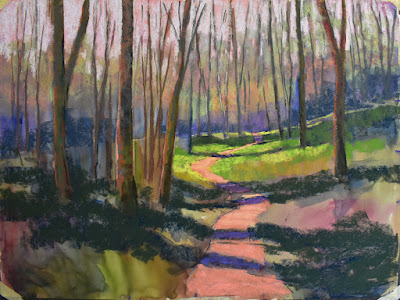The PeachHouse at Harkness Edwards Vineyards is a lovely old farmhouse which is now used for functions at the Vineyards. What a great way to repurpose an old house that has seen many years of life.
Architecture can be challenging but I divide the image into the basic format of 3rds and draw guide lines onto the reference photo. These lines really help with the placement of the basic shapes and once those basic shapes are placed then the details can be added within those blocks. When I work in plein air, I have piece of clear acrylic onto which I have also drawn the 1/3 lines and I look through that acrylic viewfinder to help with drawing accuracy. Then some basic knowledge of perspective helps which I can't go into with this blog right now.
The bottom of the house hits at the bottom 1/3 line. The roofline of the first floor on the left side of the house hits at about 1/2 of the picture plane and the roofline of the top roof hits at the top 1/3 mark. You'll see that vertical the side of the house where the evening light is hitting is at the 1/3 mark. The right side of the house hits at the vertical 1/3 mark on the right side of the photo. Yes, the photo fits nicely into the "1/3 Golden Mean" but I also cropped the original photo to fit the house into that 1/3 format.
Sketch in the basic line and then for the underpainting I add dark Nupastels for the shadowed areas and orange pastels for the sunny areas. This simple designation helps me see the design of the piece.
After applying NuPastel I washed it in with rubbing alcohol to set the underpainting.
Once the underpainting is set I applied the basic color if the image paying close attention to the value change on the side of the PeachHouse where the setting sun is shining. The setting sun shining on the house is what interested me in the image. That setting sun is also illuminating the large tree which is looming over the house - that's kind of a secondary interest - nature challenging man made objects and eventually nature will win.
The point of interest is the light on the side of the PeachHouse. That color needs to be the brightest and although the light on the tree in the photo looks equally as bright as also the light across the grass it must be subdued so the light on the house remains the most important area. At the end I added the lawn chairs for added interest but you can see that although their shape could be distracting by keeping the value dark against the shadowed lawn the chairs do not get a lot of attention.



















































